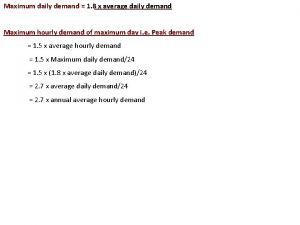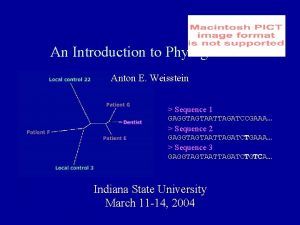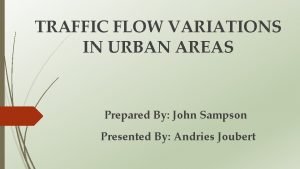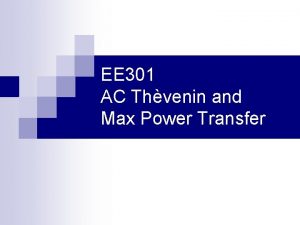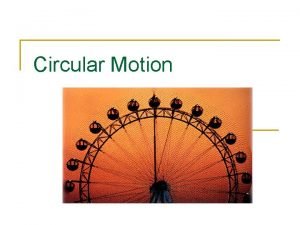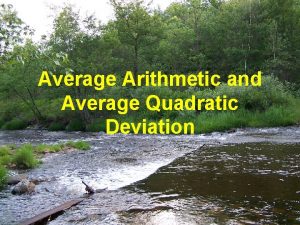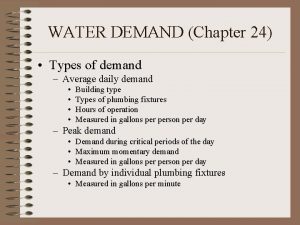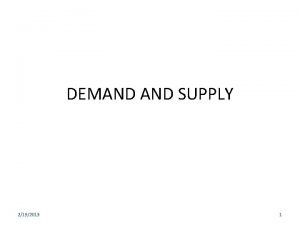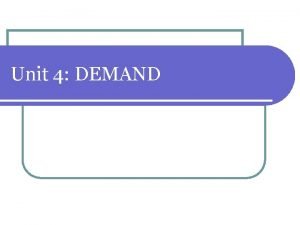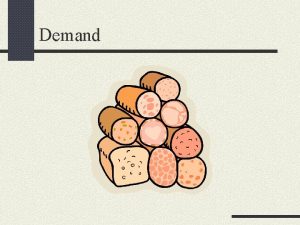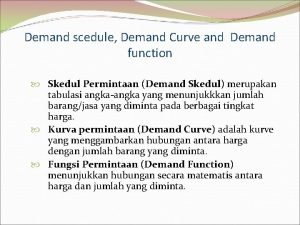Maximum daily demand 1 8 x average daily
























- Slides: 24

Maximum daily demand = 1. 8 x average daily demand Maximum hourly demand of maximum day i. e. Peak demand = 1. 5 x average hourly demand = 1. 5 x Maximum daily demand/24 = 1. 5 x (1. 8 x average daily demand)/24 = 2. 7 x average daily demand/24 = 2. 7 x annual average hourly demand

Fire demand of water is often the determining factor in the design of mains. Distribution is a short term, small quantity but with a large flow rate. According to uniform fire code, the minimum free flow requirment for a one and two family dwelling shall be 1000 gal per min. for the water demand for fire fighting based on downtown business districts and high value area for communities of 200, 000 people or less, recommended the following fire flow rate and population relationship: Q: discharge M 3/min P: population in thousands




Factors affecting per capita demand: Size of the city: Per capita demand for big. a cities is generally large as compared to that for smaller towns as big cities have sewered houses. b. Presence of industries. c. Climatic conditions. d. Habits of people and their economic status. e. Quality of water: If water is aesthetically $ medically safe, the consumption will increase as people will not resort to private wells, etc. .

. Factors affecting per capita demand: f. Pressure in the distribution system. g. Efficiency of water works administration: Leaks in water mains and services; and unauthorised use of water can be kept to a minimum by surveys. h. Cost of water. i. Policy of metering and charging method: Water tax is charged in two different ways: on the basis of meter reading and on the basis of certain fixed monthly rat e.

Sizing of Gravity Settling Tank:

Sizing of Gravity Settling Tank:

Find the area of the gravity settling required the optimal condition

Settling Solid liquid separation process in which a suspension is separated into two phases Clarified supernatant leaving the top of the sedimentation tank (overflow). . 1 Concentrated sludge leaving the bottom of the sedimentation tank (underflow). . 2 Purpose of Settling To remove coarse dispersed phase. . 1 To remove coagulated and flocculated impurities. . 2 To remove precipitated impurities after chemical treatment. . 3 To settle the sludge (biomass) after activated sludge process / tricking filters. . 4

Principle of Settling Suspended solids present in water having specific gravity greater than that of water . 1 tend to settle down by gravity as soon as the turbulence is retarded by offering storage. Basin in which the flow is retarded is called settling tank. . 2 Theoretical average time for which the water is detained in the settling tank is called . 3 the detention period.

Types of Settling Type I: Discrete particle settling - Particles settle individually without interaction with neighboring particles. Type II: Flocculent Particles – Flocculation causes the particles to increase in mass and settle at a faster rate. Type III: Hindered or Zone settling –The mass of particles tends to settle as a unit with individual particles remaining in fixed positions with respect to each other. Type IV: Compression – The concentration of particles is so high that sedimentation can only occur through compaction of the structure.


Types of Settling

Types of Settling Tanks Sedimentation tanks may function either intermittently or continuously. . 1 The intermittent tanks also called quiescent type tanks are those which store water . 2 for a certain period and keep it in complete rest. In a continuous flow type tank, the flow velocity is only reduced and the water is not . 3 brought to complete rest as is done in an intermittent type. Settling basins may be either long rectangular or circular in plan. . 4 Long narrow rectangular tanks with horizontal flow are generally preferred to the . 5 circular tanks with radial or spiral flow.

Rectangular sedimentation Tank

Circular Sedimentation Tank

Long Rectangular Settling Basin Long rectangular basins are hydraulically more stable, and flow control for large volumes is easier with this configuration. A typical long rectangular tank have length ranging from 2 to 4 times their width. The bottom is slightly sloped to facilitate sludge scraping. A slow moving mechanical sludge scraper continuously pulls the settled material into a sludge hopper from where it is pumped out periodically.

A long rectangular settling tank can be divided into four different functional zones: Inlet zone: Region in which the flow is uniformly distributed over the cross section such that the flow through settling zone follows horizontal path. Settling zone: Settling occurs under quiescent conditions. Outlet zone: Clarified effluent is collected and discharge through outlet weir. Sludge zone: For collection of sludge below settling zone.


Design Details Detention period: for plain sedimentation: 2 to 4 h, and for coagulated sedimentation: . 1 4 to 6 h. Velocity of flow: Not greater than 30 cm/min (horizontal flow). . 2 Tank dimensions: L: B = 3 to 5: 1. Generally L= 30 m (common) maximum 100 m. . 3 Breadth= 6 m to 10 m. Circular: Diameter not greater than 60 m. generally 20 to 40 m. Depth: 2. 5 to 5. 0 m (3 m). . 4 Surface Overflow Rate: For plain sedimentation 24000 to 60000 L/d/m 2 tank area; for . 5 thoroughly flocculated water 14400 to 24000 L/d/m 2 tank area. Slopes: Rectangular 1% towards inlet and circular 8%. . 6

Sedimentation Tank Design Problem: Design a rectangular sedimentation tank to treat 2. 4 million liters of raw water per day. The detention period may be assumed to be 3 hours. Solution: Raw water flow per day is 2. 4 x 106 l. Detention period is 3 h. Volume of tank = Flow x Detention period = 2. 4 x 103 x 3/24 = 300 m 3 Assume depth of tank = 3. 0 m. Surface area = 300/3 = 100 m 2 L/B = 3 (assumed). L = 3 B. 3 B 2 = 100 m 2 i. e. B = 5. 8 m L = 3 B = 5. 8 X 3 = 17. 4 m Hence surface loading (Overflow rate) = 2. 4 x 106 = 24, 000 l/d/m 2 < 40, 000 l/d/m 2 (OK) 100

General Properties of Colloids Colloidal particles are so small that their surface area in relation to mass is very large. Electrical properties: All colloidal particles are electrically charged. If electrodes from a D. C. source are placed in a colloidal dispersion, the particles migrate towards the pole of opposite charge. Colloidal particles are in constant motion because of bombardment by molecules of dispersion medium. This motion is called Brownian motion (named after Robert Brown who first noticed it). Tyndall effect: The Tyndall effect is an effect of light scattering by colloidal particles or particles in suspension. It is named after the 19 th century Irish scientist John Tyndall.
 Fire demand
Fire demand Maximum parsimony vs maximum likelihood
Maximum parsimony vs maximum likelihood Maximum likelihood vs maximum parsimony
Maximum likelihood vs maximum parsimony Absolute min and max
Absolute min and max Straight line motion
Straight line motion Average daily balance method calculator
Average daily balance method calculator Average daily traffic formula
Average daily traffic formula Cara menghitung room sold
Cara menghitung room sold 4-6 average daily balance
4-6 average daily balance Average daily balance definition
Average daily balance definition Average daily traffic formula
Average daily traffic formula Distinguish between individual demand and market demand
Distinguish between individual demand and market demand Market demand curve
Market demand curve Independent demand examples
Independent demand examples Inventory planning for independent demand items
Inventory planning for independent demand items Module 5 supply and demand introduction and demand
Module 5 supply and demand introduction and demand Independent inventory
Independent inventory Stochastic inventory model example
Stochastic inventory model example Demand forecasting and estimation
Demand forecasting and estimation Deficient demand and excess demand
Deficient demand and excess demand Ang demand schedule ay isang
Ang demand schedule ay isang Maximum power transfer theorem
Maximum power transfer theorem Hungarian maximum matching algorithm
Hungarian maximum matching algorithm Maximum principal stress theory
Maximum principal stress theory Maximum velocity in vertical circular motion
Maximum velocity in vertical circular motion
